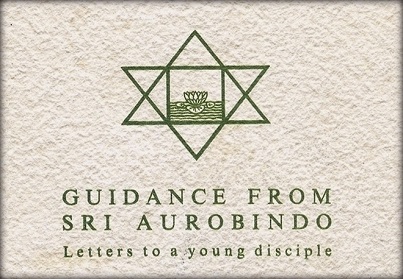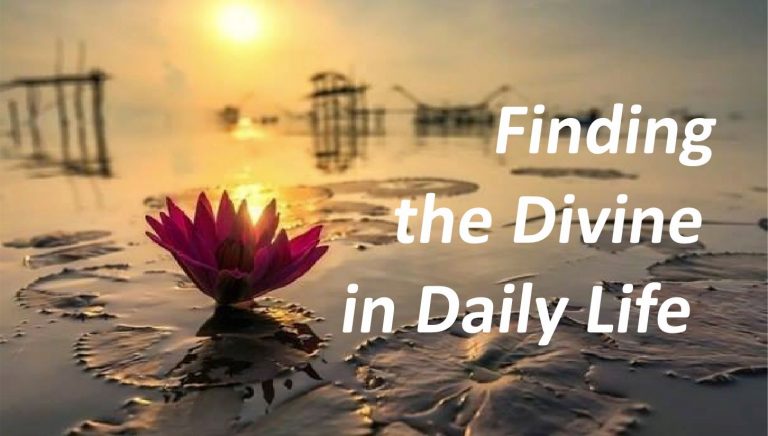
It seems someone wrote to you: “I thought there is quite a difference between divinisation and supramentalisation, one being only one of the steps to the other.” I would like to understand exactly the difference between divinisation and supramentalisation. Is not the latter implied in the former? Is not the Divine greater than the Supermind?
The Divine can be realised in any plane according to the capacity of that plane, as the Divine is everywhere. The Yogis and Saints realise the Divine on the spiritualised mind plane, that does not mean they become supramental.
Did the ancient Yogis make no distinction between the realisation of the Divine and divinisation?
They aimed at realisation and did not care about the divinisation, except the Tantrics and some others. The aim however even in these was rather to become saints and siddhas than anything else.
When people speak of ‘non-existence’, do they mean the nothingness of the Buddhists?
They mean an absence of all that we know of as existence.
Do the philosophers always make their philosophies practical?
In ancient times in Europe and at all times in the East many have done so or done their best to do so. Modern philosophy does not aim at practice, only at thought.
I came across this: “A silent or vacant mind does not necessarily mean a fit state for the true Knowledge. For anything divine or undivine may rush in through such a vacancy.” I suppose this may be a cosmic silence which is always open to any universal force (which does not care about the good or the bad). But there does exist a silence which is open only to the higher knowledge and not to the mixture below. We may call it the soul’s reticence.
Yes, except that reticence is not an apposite word, stillness is better. The cosmic silence also is not apposite because whatever forces pass through it, the cosmic silence is not disturbed or distressed by them. What they mean is an inert vacancy of the nature, not of the soul. The soul’s silence is always good; true silence always is.
I am told that all difficulties like ego, sex etc. would vanish if one says: “I am Brahman, peace, light, knowledge, power. How can anything rise against me?”
It is the Adwaita attitude corresponding to the attitude of being with the Mother above in the self. I don’t know whether it will bring about the transformation of the lower nature. It may help you to detach yourself from it.
Each religion or sect says something different about the creation of the earth. The Buddhists declare it as from nothingness; some from the Shabda (original word), the Mahabharata as from the Egg. What is actually the truth of this subject?
For the physical creation it is best to look to the knowledge Science gives. The egg is only an image — if we accept the present scientific theory of an expanding universe out of an original compact mass, the egg may represent that original mass.
It is said that before this Iron Age (Kali Yuga) there was a Golden Age (Satya Yuga). It is also said that the world is always progressing. How then comes this downward turn (Iron after Gold)?
There is no great utility in such theories. It was supposed that there was only movement in a constantly repeated cycle. The idea of progress was not there when the theory came into existence. Progress of course can be by cycles and not in a straight line, spirals with downward and upward curves.
“After all the Divine is infinite and the unrolling of the Truth may be an infinite process or at least, if not quite so much, yet with some room for new discovery and new statement…” In that case, are not the Vedas or Upanishads wrong in declaring that all the Truth is hidden in them and that there can never be any newer Truth than what is in them?
Where do the Vedas or Upanishads declare that? I never heard of it. It is people who say that about them, not the Vedas or Upanishads themselves.
Is it true that some ancient sages and Rishis have taken birth here in order to help your work?
If so, it is not a fact of much importance.
I fail to understand how the ancient Yogis managed to spend their whole lives in only one pursuit — self-realisation? Is it really such a long process?
It is not a long process? The whole life and several lives more are often not enough to achieve it. Ramakrishna’s guru took 30 years to arrive and even then he did not claim that he had realised it.
In his book “A Search in Secret India”, Paul Brunton writes about “The Sage Who Never Speaks”. He remains in Samadhi day and night and comes out only once or twice for food etc. What usually does he do during such long periods in trance, since his goal is not so high?
Do? Why should he want to do anything if he was in the eternal peace or Ananda or union with the Divine? If a man is spiritual and has gone beyond the vital and mind, he does not need to be always “doing” something. The self or spirit has the joy of its own existence. It is free to do nothing and free to do everything — but not because it is bound to action and unable to exist without it.
By my question, “What does he do?” I did not mean any physical or mental action. Rather I wanted to know if by merely remaining in a samadhi of eternal Peace and Ananda, it would be possible to liberate oneself completely from the ego. Would it bring about other necessary changes like the purification and transformation?
Without purification it is not possible to live always in the Brahman consciousness. While living in that Brahman consciousness one is free from the sense of a separative ego. As for the transformation of the nature, that is not their object.
In asking this I wanted to understand how he could bring down the higher things into the lower and conquer the lower resistance, and whether all that could be achieved by an impersonal and eternal Calm and Delight.
All that is not necessary for those who seek only liberation as end.
In the same book Brunton has discussed the central teachings of some great Yogis of modern India. I find nothing new in them. They seem like a repetition of the Yogas of ancient India. To leave the world and seek self-realisation is their goal. All that does not appear to me a very difficult stage.
Wonderful! The realisation of the Self which includes the liberation from the ego, the consciousness of the One in all, the established and consummated transcendence out of the universal Ignorance, the fixity of the consciousness in the union with the Highest, the Infinite and Eternal is not anything worth doing or recommending to anybody — is “not a very difficult stage”!
Nothing new! Why should there be anything new? The object of spiritual seeking is to find out, what is eternally true, not what is new in Time.
From where did you get this singular attitude towards the old Yogas and Yogis? Is the wisdom of the Vedanta and Tantra a small and trifling thing? Have then the sadhaks of this Ashram attained to self-realisation and are they liberated Jivan-muktas, free from ego and ignorance? If not, why then do you say, “it is not a difficult stage” “their goal is not so high” “is it such a long process”?
I have said that this Yoga is “new” because it aims at a change in this world and not only beyond it and at a supramental realisation. But how does that justify a superior contempt for the spiritual realisation which is as much the aim of this Yoga as of any other?
It becomes clear now that I had some fundamentally wrong ideas about the old Yogas and Yogins. They were actually not my own but borrowed from some sadhaks. Still I am not quite clear about the old Yogas.
I have heard that people from outside often find the sadhaks here full of an insufferable pride and arrogance, looking on all others as outsiders far below them! If it is so, it is a most foolish and comically ridiculous attitude.
As for the depreciation of the old Yogas as something quite easy, unimportant and worthless, and the depreciation of Buddha and Yajnavalkya and other great spiritual figures of the past, is it not evidently absurd on the face of it?
Is it not a fact that the mind, vital and physical are integrally woven into each other and that to separate them and put each one in its proper place is no easy task.
When the mind alone is realising the self, the vital and physical will constantly try to disturb it. (One cannot do this realisation in all these beings together.) Thus the necessity of separating them becomes inevitable. Do you think that they all can be fundamentally separated without the help of the supramental planes, the planes above the human mind?
There are many planes above man’s mind — the supramental is not the only one, and on all of them the self can be realised, — for they are all spiritual planes.
Mind, vital and physical are inextricably mixed together only on the surface consciousness — the inner mind, inner vital, inner physical are separate from each other. Those who seek the self by the old Yogas separate themselves from mind, life and body and realise the self of it from these things. It is perfectly easy to separate mind, vital and physical from each other without the aid of supermind. It is done by the ordinary Yogas.
You wrote the other day, “Certainly they can realise the self. It is not at all necessary to get the supramental planes for that.” Then what is the fundamental difference between our Yoga and the old Yogas?
The difference between this and the old Yogas is not that they are incompetent and cannot do these things — they can do them perfectly well; but that they proceed from realisation of self to Nirvana or some Heaven and abandon life, while this does not abandon life. The supramental is necessary for the transformation of terrestrial life and being, not for reaching the self. One must realise self first — only afterwards one can realise the supermind.
You wrote, “Those who seek the self by the old Yogas separate themselves from mind, life and body and realise the self apart from these things.” How do they manage to separate themselves from mind, life and body so easily? Will not these things interfere with their realisation? In allowing them to do this, will not the mind, vital and physical have to withdraw from their ordinary movements of tamas, rajas and sattwa?
Of course they will — it can only be prevented by the lower movements if you assent to the lower movements; one who refuses to accept them as his real being can always withdraw from them to the self. The movements of Nature become for them an outer thing not belonging to their true being and having no power to pull them down from it.
These men who live in the self are always there at all times. Nothing in the outer nature can affect that.
Is there any difference between our way of seeking the self and that of the old Yogis?
Only that they often sought it by one line, the line varying in different Yogas, while in ours it may come in several ways.
I suppose anyone who wants to realise the self cannot do it except by separating oneself from mind, life and body.
Naturally.
While referring to the supramental planes lately, I did not mean the supermind, but simply the spiritual planes above the human mind. To separate mind, vital and physical from each other, is there no need of the higher spiritual planes?
Spiritual and supramental are not the same thing. The spiritual planes from higher mind to overmind are accessible to the old sadhanas so there is no difficulty about that. If they were not accessible there would have been no Yoga at all and no Yogis in the past in India.
Your above answer regarding the spiritual planes and supramental planes urges me to inquire about the exact difference between spiritualisation and supramentalisation.
Spiritualisation means the descent of the higher peace, force, light, knowledge, purity, Ananda etc. which belong to any of the higher planes from higher mind to Overmind, for in any of these the Self can be realised. It brings about a subjective transformation; the instrumental Nature is only so far transformed that it becomes an instrument for the Cosmic Divine to get some work done while the self within remains calm and free and united to the Divine. But this is an incomplete individual transformation — the full transformation of the instrumental Nature can only come when the Supramental change takes place. Till then the nature remains full of many imperfections, but the Self in the higher planes does not mind them, as it is itself free and unaffected. The inner being down to the inner physical can also become free and unaffected. The Overmind itself is subject to limitations in the working of the effective Knowledge, limitations in the working of the Power, subject to a partial and limited Truth etc. It is only in the Supermind that the full Truth-Consciousness comes into being.
When you say that the self also can descend, is it the self as such that comes down or as peace, purity, knowledge etc.?
As consciousness bringing all the rest after it.
Is this self a consciousness or a being like the psychic?
It is being, not a being. By self is meant the conscious essential existence one in all.
Will you kindly elaborate the difference between “being” and “a being”?
I suppose you would have to study philosophy in order to understand. Self is being, the essential conscious existence one in all, that is being. A being means one person out of many; an individualised conscious existence.
When I asked you if the self was being or consciousness, I meant the self in its individualised aspect and not in its original universal status.
The self is essentially universal; the individualised self is only the universal experienced from an individual centre. If what you have realised is not felt to be one in all, then it is not the “Atman”, only it is the central being not yet revealing its universal aspect as Atman.



About Savitri | B1C1-10 The Response of Earth (p.5)